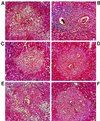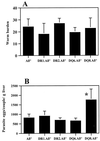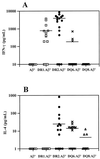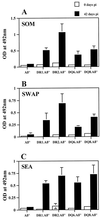HLA class II polymorphism influences onset and severity of pathology in Schistosoma mansoni-infected transgenic mice
- PMID: 11500466
- PMCID: PMC98706
- DOI: 10.1128/IAI.69.9.5874-5882.2001
HLA class II polymorphism influences onset and severity of pathology in Schistosoma mansoni-infected transgenic mice
Abstract
Genetic factors that might influence susceptibility or resistance in naive individuals and early-stage pathology in schistosomiasis are difficult to study in clinical trials, since in areas where the disease is endemic the first contact with the parasite occurs most often at very early ages. Therefore, four strains (DR1.Abeta degrees, DR2.Abeta degrees, DQ8.Abeta degrees, and DQ6.Abeta degrees ) of major histocompatibility complex class II-deficient mice (Abeta degrees ), transgenic for different HLA alleles, have been used to evaluate the potential role of HLA class II polymorphism in the onset of the infection by Schistosoma mansoni. The survival rates and parasitological and immunological parameters after infection were evaluated and compared against the control values obtained with Abeta degrees mice. All four mouse strains used in this study were able to generate a specific immune response against S. mansoni antigens (cytokine production and antibody production). However, only mice expressing DR alleles survived until the chronic stage of the infection and were able to mount protective granulomatous response avoiding hepatic damage, presenting predominant gamma interferon production. In contrast, strains expressing DQ alleles revealed an impairment in generating effective granulomas, resulting in earlier death, which was associated with an impaired hepatic granulomatous response and liquefactic necrosis, reflecting the influence of HLA polymorphism in the establishment of protective response in the early stage of infection.
Figures






Similar articles
-
Immunological response of major histocompatibility complex class II-deficient (Abeta(o)) mice infected by the parasite Schistosoma mansoni.Scand J Immunol. 1998 Aug;48(2):159-69. doi: 10.1046/j.1365-3083.1998.00372.x. Scand J Immunol. 1998. PMID: 9716107
-
Influence of the HLA-DQB1*0201 allele on the immune response in a Schistosoma mansoni infection.Acta Trop. 2008 Nov-Dec;108(2-3):131-4. doi: 10.1016/j.actatropica.2008.04.004. Epub 2008 Apr 15. Acta Trop. 2008. PMID: 18495081
-
HLA-DQ polymorphism influences progression of demyelination and neurologic deficits in a viral model of multiple sclerosis.Mol Cell Neurosci. 2000 Jun;15(6):495-509. doi: 10.1006/mcne.2000.0843. Mol Cell Neurosci. 2000. PMID: 10860577 Free PMC article.
-
Human schistosomiasis mansoni: immune responses during acute and chronic phases of the infection.Acta Trop. 2008 Nov-Dec;108(2-3):109-17. doi: 10.1016/j.actatropica.2008.05.027. Epub 2008 Jun 5. Acta Trop. 2008. PMID: 18577364 Review.
-
HLA and H2 class II transgenic mouse models to study susceptibility and protection in autoimmune thyroid disease.Autoimmunity. 2003 Sep-Nov;36(6-7):397-404. doi: 10.1080/08916930310001603028. Autoimmunity. 2003. PMID: 14669947 Review.
Cited by
-
Major histocompatibility complex class II molecule-human immunodeficiency virus peptide analysis using a microarray chip.Clin Vaccine Immunol. 2009 Apr;16(4):567-73. doi: 10.1128/CVI.00441-08. Epub 2009 Feb 18. Clin Vaccine Immunol. 2009. PMID: 19225081 Free PMC article.
-
Cardiac phosphatase-deficient 6-phosphofructo-2-kinase/fructose-2,6-bisphosphatase increases glycolysis, hypertrophy, and myocyte resistance to hypoxia.Am J Physiol Heart Circ Physiol. 2008 Jun;294(6):H2889-97. doi: 10.1152/ajpheart.91501.2007. Epub 2008 May 2. Am J Physiol Heart Circ Physiol. 2008. PMID: 18456722 Free PMC article.
-
Major histocompatibility complex (MHC) class II but not MHC class I molecules are required for efficient control of Strongyloides venezuelensis infection in mice.Immunology. 2009 Sep;128(1 Suppl):e432-41. doi: 10.1111/j.1365-2567.2008.02995.x. Epub 2008 Dec 16. Immunology. 2009. PMID: 19191916 Free PMC article.
-
Identification of a linear B-cell epitope on the Schistosoma japonicum saposin protein, SjSAP4: Potential as a component of a multi-epitope diagnostic assay.PLoS Negl Trop Dis. 2022 Jul 11;16(7):e0010619. doi: 10.1371/journal.pntd.0010619. eCollection 2022 Jul. PLoS Negl Trop Dis. 2022. PMID: 35816547 Free PMC article.
-
The quality of methods reporting in parasitology experiments.PLoS One. 2014 Jul 30;9(7):e101131. doi: 10.1371/journal.pone.0101131. eCollection 2014. PLoS One. 2014. PMID: 25076044 Free PMC article.
References
-
- Amiri P, Locksley R, Parslow T, Sadick M, Rector E, Ritter D, McKerrow J. Tumor necrosis factor α restores granulomas and induces parasite egg-laying in schistosome-infected SCID mice. Nature. 1992;356:604–607. - PubMed
-
- Angyalosi G, Pancré V, Herno J, Auriault C. Immunological response of major histocompatibility complex class II-deficient (Aβ°) mice infected by the parasite Schistosoma mansoni. Scand J Immunol. 1998;48:159–169. - PubMed
-
- Chandrasekharappa S, Rebelsky R M, Firak T A, Le Beau M M, Westbrook C A. A long-range map of the interleukin-4 and interleukin-5 linkage group on chromosome. Genomics. 1990;6:94–99. - PubMed
Publication types
MeSH terms
Substances
LinkOut - more resources
Full Text Sources
Molecular Biology Databases
Research Materials

